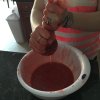My wife and I swung by our local homebrew supply yesterday on our way home from Roseburg (the nearest city with a Home Depot or Lowes... yeah) and were really impressed with their selection. They sell equipment for beer, wine (and mead), distilling, candle making, soap making, tincture making, capsule filling, cheese making, bread baking (sourdough starters and such), charcuterie, and more; and they have ready-to-purchase samples of all of those categories of products. They also do homesteading supplies and instruction. We will definitely be spending a lot of time and money there. To kick things off though, we picked up a bottle of Dansk Mjod's Viking Blod. Now I can say I've had two one(?) great commercial mead(s), and that I have something to which to aspire. The first was an excellent black currant "honey wine" from Nalewka Babuni (which at the time was explained to us as a mead... now, after a brief Google perusal, I'm really not so sure). I was afraid the hops were going to overpower everything else - especially since having a few of the local beers. I really don't understand why Oregonians hate their palates so much. It must be a cultural guilt thing. But the balance of the honey, hibiscus, hops, and whatever other spices they use was very well done. I'd say I probably lucked into getting a half-way comparable result with my Christmas mead, so I should start there in my quest to make truly good mead.
Maybe I'll carry on the theme of special occasion meads. I have a Christmas mead and a Wife's Birthday mead, I could go with a Vernal Equinox mead. I did a big "First Day of Spring" themed dinner last year, I could go back through my notes and find some spices for a Metheglin, or maybe a spiced Melomel; pick some ingredients indigenous to our new home region, and then as an extra treat/challenge, carbonate a few bottles of the batch. I'll need to replace literally every piece of my brewing kit - yeah, ouch. But, since we definitely don't have to move any time soon, and I have some time to accumulate gear again, that means I can buy really good equipment. So, any recommendations for equipment that I shouldn't be without? The basics I know - brewing bucket, hydrometer, something in which to float said hydrometer, airlock, racking cane, carboy, bottling bucket, bottling wand, bottles and either flip-top lids or a floor corker/crown capper. Any brands I look out for, or other pieces of equipment that fall outside the "basics" category?









